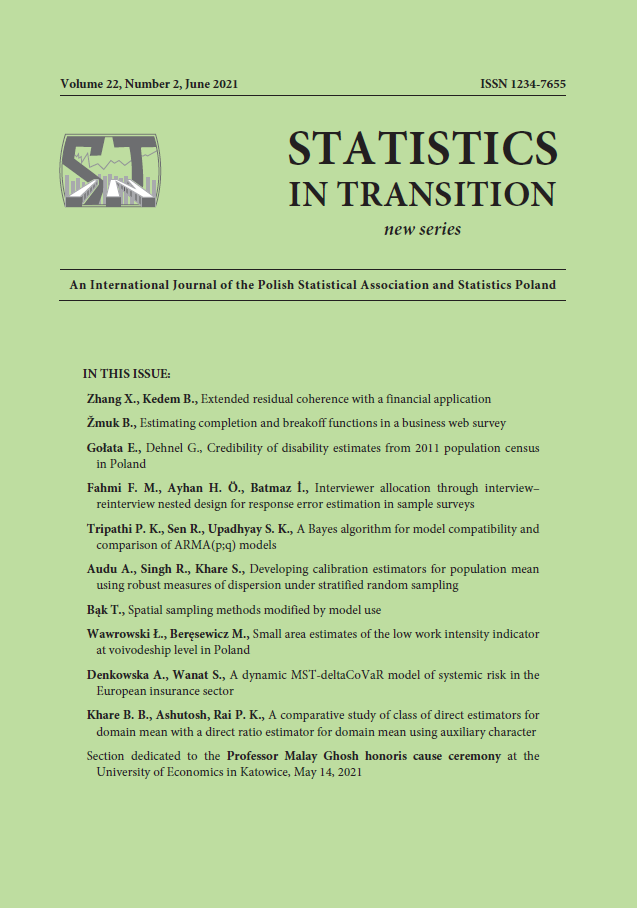ARTICLE
ABSTRACT
The EU Statistics on Income and Living Conditions (EU-SILC) has provided annual estimates of the number of labour market indicators for EU countries since 2003, with an almost exclusive focus on national rates. However, it is impossible to obtain reliable direct estimates of labour market statistics at low levels based on the EU-SILC survey. In such cases, modelbased small area estimation can be used. In this paper, the low work intensity indicator for the spatial domains in Poland between 2005-2012 was estimated. The Rao and You (1994), Fay and Diallo (2012), and Marhuenda, Molina and Morales (2013) models were applied. The bootstrap MSE for the discussed methods was proposed. The results indicate that these models provide more reliable estimates than direct estimation.
KEYWORDS
EU-SILC, low work intensity, labour market, small area estimation, temporal models, spatio-temporal models
REFERENCES
Brown, G., Chambers, R., Heady, P., Heasman, D., (2001). Evaluation of small area estimation methods – an application to unemployment estimates from the UK LFS. Proceedings of Statistics Canada Symposium.
Bivand, R., Pebesma, E., Gomez-Rubio, V., (2013). Applied spatial data analysis with R, Second edition. Springer. New York.
Chandra, H., Chambers, R., Salvati, N., (2012). Small area estimation of proportions in business surveys. Journal of Statistical Computation and Simulation, 82(6), pp. 783– 795.
Chatterjee, S., Price, B., (1991). Regression Diagnostics, New York: John Wiley.
Dehnel, G., Wawrowski, Ł., (2020). Robust estimation of wages in small enterprises: the application to Poland’s districts. Statistics in Transition New Series, 21(1), pp. 137– 157.
Deville, J. C., Särndal, C. E., (1992). Calibration estimators in survey sampling. Journal of the American Statistical Association, 87, 376–382.
Fay, R. E., Diallo, M. S., (2012). Small Area Estimation Alternatives for the National Crime Victimization Survey. Proceedings of the Section on Survey Research Methods. American Statistical Association, pp. 3742–3756.
Fay, R. E., Diallo, M. S., (2015). sae2: Small Area Estimation: Time-series Models. R package.
Fay, R. E., Herriot, R. A., (1979). Estimates of income for small places: an application of James-Stein procedures to census data. Journal of the American Statistical Association, 74, pp. 269–277.
Fay, R. E., Planty, M., Diallo, M. S., (2013). Small area estimates from the national crime victimization survey. Proceedings of the Section on Survey Research Methods. American Statistical Association, pp. 1544–1557.
Fox, J., Monette, G., (1992). Generalized collinearity diagnostics. Journal of the American Statistical Association, 87, pp. 178–183.
GonzáLez-Manteiga,W., LombardíA, M., Molina, I., Morales, D., SantamaríA, L., (2008). Bootstrap mean squared error of a small-area EBLUP. Journal of Statistical Computation and Simulation, 78, pp. 443–462.
Greven, S., Kneib, T., (2010). On the behaviour of marginal and conditional AIC in linear mixed models. Biometrika, 97(4), pp. 773–789.
Henderson, C. R., (1975). Best linear unbiased estimation and prediction under a selection model. Biometrics 31, pp. 423–447.
Li, J., Valliant, R., (2015). Linear Regression Diagnostics in Cluster Samples. Survey Methodology, 31, pp. 61–75.
Liao, D., Valliant, R., (2012)., Variance inflation factors in the analysis of complex survey data. Survey Methodology, 38, pp. 53–62.
López-Vizcaíno, E., Lombardía, M. J., Morales, D., (2013). Multinomial-based small area estimation of labour force indicators. Statistical Modelling,13(2), pp. 153–178, doi:10.1177/1471082X13478873.
Marhuenda, Y., Molina, I., Morales, D., (2013). Small area estimation with spatio-temporal Fay–Herriot models. Computational Statistics and Data Analysis, 58, pp. 308–325.
Mélina, A., Emilio, D. M., (2012). 23% of EU citizens were at risk of poverty or social exclusion in 2010. Statistics in Focus, 9, pp. 1–7.
Molina, I., Marhuenda, Y., (2015). sae: An R package for small area estimation. The R Journal, 7(1), pp. 81–98.
Molina, I., Rao, J. N. K., (2010). Small area estimation of poverty indicators. The Canadian Journal of Statistics, 38(3), pp. 369–385.
Molina, I., Salvati, N., Pratesi, M., (2009). Bootstrap for estimating the MSE of the Spatial EBLUP. Computational Statistics, 24, pp. 441–458.
Nakagawa, S., Schielzeth, H., (2013). A general and simple method for obtaining R2 from generalized linear mixed-effects models. Methods in Ecology and Evolution, 4, pp. 133–142.
Prasad, N., Rao, J. N. K., (1990). The estimation of the mean squared error of small-area estimators. Journal of the American Statistical Association, 85, pp. 163–171.
Rao, J. N. K., Molina, I., (2015). Small Area Estimation. Wiley and Sons.
Rao, J. N. K., Yu, M., (1994). Small-area estimation by combining time-series and crosssectional data. Canadian Journal of Statistics, 22, pp. 511–528.
Saefken, B., Ruegamer, D., Kneib, T., Greven, S., (2018). Conditional Model Selection in Mixed-Effects Models with cAIC4, ArXiv e-prints 1803.05664.
Statistics Poland, (2014). Incomes and living conditions of the population of Poland —- report from the EU-SILC survey of 2012. Statistical Publishing Establishment. Warsaw.
Szymkowiak, M., Młodak, A., Wawrowski, Ł., (2017). Mapping poverty at the level of subregions in Poland using indirect estimation. Statistics in Transition new series, 18(4), pp. 609–635.
Viechtbauer, W., (2010). Conducting meta-analyses in R with the metafor package. Journal of Statistical Software, 36(3), pp. 1–48.
Ward, T., Ozdemir, E., (2013). Measuring low work intensity –– an analysis of the indicator. ImPRovE Discussion Paper, 13, pp. 1–37.
